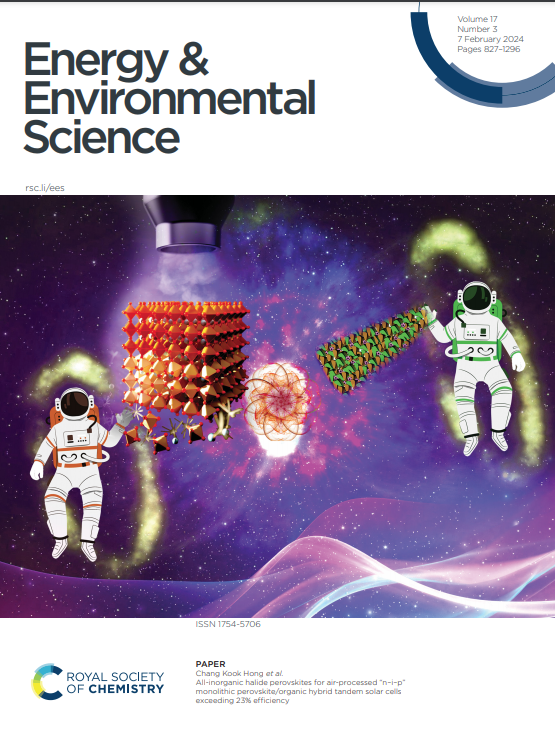LIBs石墨阳极中隐藏的亚表面分子气泡
IF 30.8
1区 材料科学
Q1 CHEMISTRY, MULTIDISCIPLINARY
引用次数: 0
摘要
在石墨阳极-电解质界面,溶剂共插层、固体电解质界面(SEI)形成和气体演化之间的相互作用对电池性能起着至关重要的作用,但在纳米尺度上对其知之甚少。在这项研究中,我们引入了基于超声的操作原子力显微镜(AFM),它打破了基于超声技术的空间分辨率限制,以可视化锂离子电池石墨阳极中溶剂共插层,SEI形成和地下气体演化的动力学。值得注意的是,我们观察到气体的演化导致了“地下分子气泡”的形成——被困在石墨层之间的气体袋——在电池形成周期中损害了界面的稳定性。原子力显微镜和密度泛函理论计算结果表明,这些亚表面分子气泡主要是由Li+(EC)4溶剂化配合物的共插和分解引起的。我们还发现,通过优化脱溶剂能和界面分子结构,加入低介电常数、非溶剂化的稀释溶剂(氟化苯)可以完全抑制溶剂共插层和层间分解效应。通过将这种优化的电解质应用于石墨/锂半电池和锂钴氧化物(LCO)/石墨全电池,我们实现了稳定的循环,在高倍率(0.5 C)电池形成过程中,分子气泡形成可以忽略不计,SEI生长紧凑,库仑效率高(>93%)。本文章由计算机程序翻译,如有差异,请以英文原文为准。
Hidden Subsurface Molecular Bubbles in Graphite Anodes for LIBs
The interplay between solvent co-intercalation, solid-electrolyte interface (SEI) formation, and gas evolution at the graphite anode-electrolyte interface plays a critical role in battery performance, yet it remains poorly understood at the nanoscale. In this study, we introduce ultrasound-based operando atomic force microscopy (AFM), which breaks the spatial-resolution limitation of ultrasound-based techniques, to visualize the dynamics of solvent co-intercalation, SEI formation, and subsurface gas evolution in graphite anodes for lithium-ion batteries. Remarkably, we observe that gas evolution leads to the formation of “subsurface molecular bubbles”—gaseous pockets trapped between graphite layers—that compromise interfacial stability during battery formation cycles. AFM and Density Functional Theory calculations results revealed that these subsurface molecular bubbles are primarily induced by the co-intercalation and decomposition of Li+(EC)4 solvation complexes. We also found the solvent co-intercalation and interlayer decomposition effects can be fully suppressed by incorporating a low-permittivity, non-solvating diluent solvent (fluoride benzene) through optimizing the de-solvation energy and the interfacial molecular architectures. By applying this optimized electrolyte in both graphite/Li half-cells and lithium cobalt oxide (LCO)/graphite full-cells, we achieve stable cycling with negligible molecular bubble formation, compact SEI growth, and high coulombic efficiency (>93%) during high-rate (0.5 C) battery formation.
求助全文
通过发布文献求助,成功后即可免费获取论文全文。
去求助
来源期刊

Energy & Environmental Science
化学-工程:化工
CiteScore
50.50
自引率
2.20%
发文量
349
审稿时长
2.2 months
期刊介绍:
Energy & Environmental Science, a peer-reviewed scientific journal, publishes original research and review articles covering interdisciplinary topics in the (bio)chemical and (bio)physical sciences, as well as chemical engineering disciplines. Published monthly by the Royal Society of Chemistry (RSC), a not-for-profit publisher, Energy & Environmental Science is recognized as a leading journal. It boasts an impressive impact factor of 8.500 as of 2009, ranking 8th among 140 journals in the category "Chemistry, Multidisciplinary," second among 71 journals in "Energy & Fuels," second among 128 journals in "Engineering, Chemical," and first among 181 scientific journals in "Environmental Sciences."
Energy & Environmental Science publishes various types of articles, including Research Papers (original scientific work), Review Articles, Perspectives, and Minireviews (feature review-type articles of broad interest), Communications (original scientific work of an urgent nature), Opinions (personal, often speculative viewpoints or hypotheses on current topics), and Analysis Articles (in-depth examination of energy-related issues).
 求助内容:
求助内容: 应助结果提醒方式:
应助结果提醒方式:


